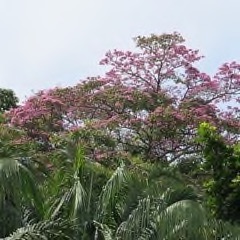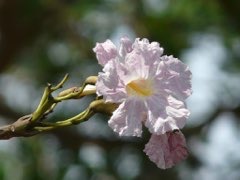 |
|
Alamus15 wikimedia.org |
 |
| Dinesh Valke from Thane, India wikimedia.org |
Translate this page:
Summary
Tabebuia rosea or commonly known as Apamate or Rosy Trumpert Tree is a large, tropical tree growing up to 30 m in height. The leaves are compound. Other common names are Pink Poui and Roble de Sabana. It is the national tree of El Salvador. It has a spreading crown and an often buttressed, straight bole that can be up to 1 m in diameter. The flowers are large and pink and first occur after three years after planting. The bark can be gray or brown. Leaves are compound, composed of five leaflets each. The fruits, long and slender capsules, are not edible. T. rose is not cultivated for food. Otherwise, it functions as a shade tree in coffee and cocoa plantations. Medicinally, it is used for anemia, constipation, fevers, pain, and tonsillitis. The wood is moderately light and soft but makes an excellent timber. It is ideal for heavy construction, furniture, cabinet making, interior finish, boat building, carts, etc. Propagation of this plant is by woody stem cuttings, seeds sowing, and air layering.
Physical Characteristics

 Tabebuia rosea is a deciduous Tree growing to 20 m (65ft) by 20 m (65ft) at a medium rate.
Tabebuia rosea is a deciduous Tree growing to 20 m (65ft) by 20 m (65ft) at a medium rate.
See above for USDA hardiness. It is hardy to UK zone 10.
Suitable for: light (sandy), medium (loamy) and heavy (clay) soils and prefers well-drained soil. Suitable pH: mildly acid, neutral and basic (mildly alkaline) soils and can grow in very acid and very alkaline soils.
It cannot grow in the shade. It prefers dry or moist soil.
UK Hardiness Map
US Hardiness Map
Synonyms
Bignonia pentaphylla L. Couralia rosea (Bertol.) Donn.Sm. Sparattosperma rosea (Bertol.) Miers Tabeb
Plant Habitats
Edible Uses
References More on Edible Uses
Medicinal Uses
Plants For A Future can not take any responsibility for any adverse effects from the use of plants. Always seek advice from a professional before using a plant medicinally.
Antiinflammatory Cancer Diaphoretic Febrifuge Laxative Malaria Parasiticide
Bark used to eliminate intestinal parasites, malaria and uterine cancer. A decoction of the bark is recommended for anemia and constipation. A decoction of the flowers, leaves and roots has been used to reduce fevers and pain, cause sweating, to treat tonsil inflammation and various other disorders (Hernan Rodriguez Navas. 2007. La Utilidad de las Plantas Medicinales en Costa Rica. EUNA, Heredia, Costa Rica).
Active phytochemicals in the tree include lapachol, a natural organic compound isolated from various other Tabebuia species. Chemically, it is a derivative of naphthoquinone, related to vitamin K.
References More on Medicinal Uses
The Bookshop: Edible Plant Books
Our Latest books on Perennial Plants For Food Forests and Permaculture Gardens in paperback or digital formats.

Edible Tropical Plants
Food Forest Plants for Hotter Conditions: 250+ Plants For Tropical Food Forests & Permaculture Gardens.
More

Edible Temperate Plants
Plants for Your Food Forest: 500 Plants for Temperate Food Forests & Permaculture Gardens.
More

More Books
PFAF have eight books available in paperback and digital formats. Browse the shop for more information.
Shop Now
Other Uses
Furniture Parasiticide Wood
Agroforestry Uses: The tree is used to provide shade in coffee and cocoa plantations[362 ]. Other Uses The wood is a rather dull greyish brown with a fine striping of deep brown, often in a conspicuous pattern on the tangential surface[331 ]. It is without distinctive odour or taste; the grain is usually straight, but sometimes roey or wavy; the texture medium. The wood is moderately light and soft to rather hard and heavy; fairly durable. It is easy to work, finishes smoothly, seasons without difficulty. It is said that if the wood is cut green and stacked to dry, it acquires a dark colour, without losing its striping, and is then of different appearance from wood treated in the more usual manner[331 ]. An excellent timber, it is used for a great variety of purposes such as heavy construction; furniture and cabinetwork; interior finish; boat building; carts, and many other kinds of work[331 ]. A large part of the cheaper chairs of Central America are made from this wood[331 ].
Special Uses
References More on Other Uses
Cultivation details
A plant of the moist tropics, where it is found at elevations from 100 - 1,200 metres. It grows best in areas where annual daytime temperatures are within the range 22 - 30c, but can tolerate 17 - 34c[418 ]. It prefers a mean annual rainfall in the range 1,500 - 2,000mm, but tolerates 1,250 - 2,500mm[418 ]. Grows best in a sunny position[418 ]. Succeeds in most soils that are fertile[418 ]. Prefers a pH in the range 5.5 - 7, tolerating 4.5 - 8.5[418 ]. Requires a somewhat sheltered position because branches are easily broken by strong winds[303 , 418 ]. This species can sometimes be invasive[307 ]. Trees can commence flowering when only 3 years old from seed[362 ]. Annual wood production potential is 10 - 20 metric tonnes per hectare[418 ]. Flowering Time: Mid Spring Late Spring/Early Summer(early spring, mid spring, late spring). Bloom Color: Pale Pink Violet/Lavender White/Near White(red, pink, white). Spacing: 30-40 ft. (9-12 m).
References Carbon Farming Information and Carbon Sequestration Information
Temperature Converter
Type a value in the Celsius field to convert the value to Fahrenheit:
Fahrenheit:
The PFAF Bookshop
Plants For A Future have a number of books available in paperback and digital form. Book titles include Edible Plants, Edible Perennials, Edible Trees,Edible Shrubs, Woodland Gardening, and Temperate Food Forest Plants. Our new book is Food Forest Plants For Hotter Conditions (Tropical and Sub-Tropical).
Shop Now
Plant Propagation
Seed - best sown as soon as it is ripe[200 ]. Germination usually takes place in 3 - 4 days[362 ]. Cuttings of half-ripe wood[200 ]. Air layering.
Other Names
If available other names are mentioned here
Broble, oaka.
Native Range
NORTHERN AMERICA: Mexico (Durango, San Luis Potosí, Sinaloa, Sonora, Tamaulipas, Zacatecas, Campeche, Chiapas, Colima, Guerrero, Hidalgo, Jalisco, México, Michoacán de Ocampo, Morelos, Nayarit, Oaxaca, Puebla, Querétaro, Quintana Roo, Tabasco, Veracruz de Ignacio de la Llave, Yucatán) SOUTHERN AMERICA: Belize, Costa Rica, Guatemala, Honduras, Nicaragua, Panama, El Salvador, Venezuela, Colombia, Ecuador (west)
Weed Potential
Right plant wrong place. We are currently updating this section.
Please note that a plant may be invasive in one area but may not in your area so it's worth checking.
This species can sometimes be invasive[307 ].
Conservation Status
IUCN Red List of Threatened Plants Status : This taxon has not yet been assessed

Growth: S = slow M = medium F = fast. Soil: L = light (sandy) M = medium H = heavy (clay). pH: A = acid N = neutral B = basic (alkaline). Shade: F = full shade S = semi-shade N = no shade. Moisture: D = dry M = Moist We = wet Wa = water.
Now available:
Food Forest Plants for Mediterranean Conditions
350+ Perennial Plants For Mediterranean and Drier Food Forests and Permaculture Gardens.
[Paperback and eBook]
This is the third in Plants For A Future's series of plant guides for food forests tailored to
specific climate zones. Following volumes on temperate and tropical ecosystems, this book focuses
on species suited to Mediterranean conditions—regions with hot, dry summers and cool, wet winters,
often facing the added challenge of climate change.
Read More
Expert comment
Author
(Bertol.) DC.
Botanical References
Links / References
For a list of references used on this page please go here
A special thanks to Ken Fern for some of the information used on this page.
Readers comment
| Add a comment |
|
If you have important information about this plant that may help other users please add a comment or link below. Only comments or links that are felt to be directly relevant to a plant will be included. If you think a comment/link or information contained on this page is inaccurate or misleading we would welcome your feedback at [email protected]. If you have questions about a plant please use the Forum on this website as we do not have the resources to answer questions ourselves.
* Please note: the comments by website users are not necessarily those held by PFAF and may give misleading or inaccurate information.
To leave a comment please Register or login here All comments need to be approved so will not appear immediately.
|
|